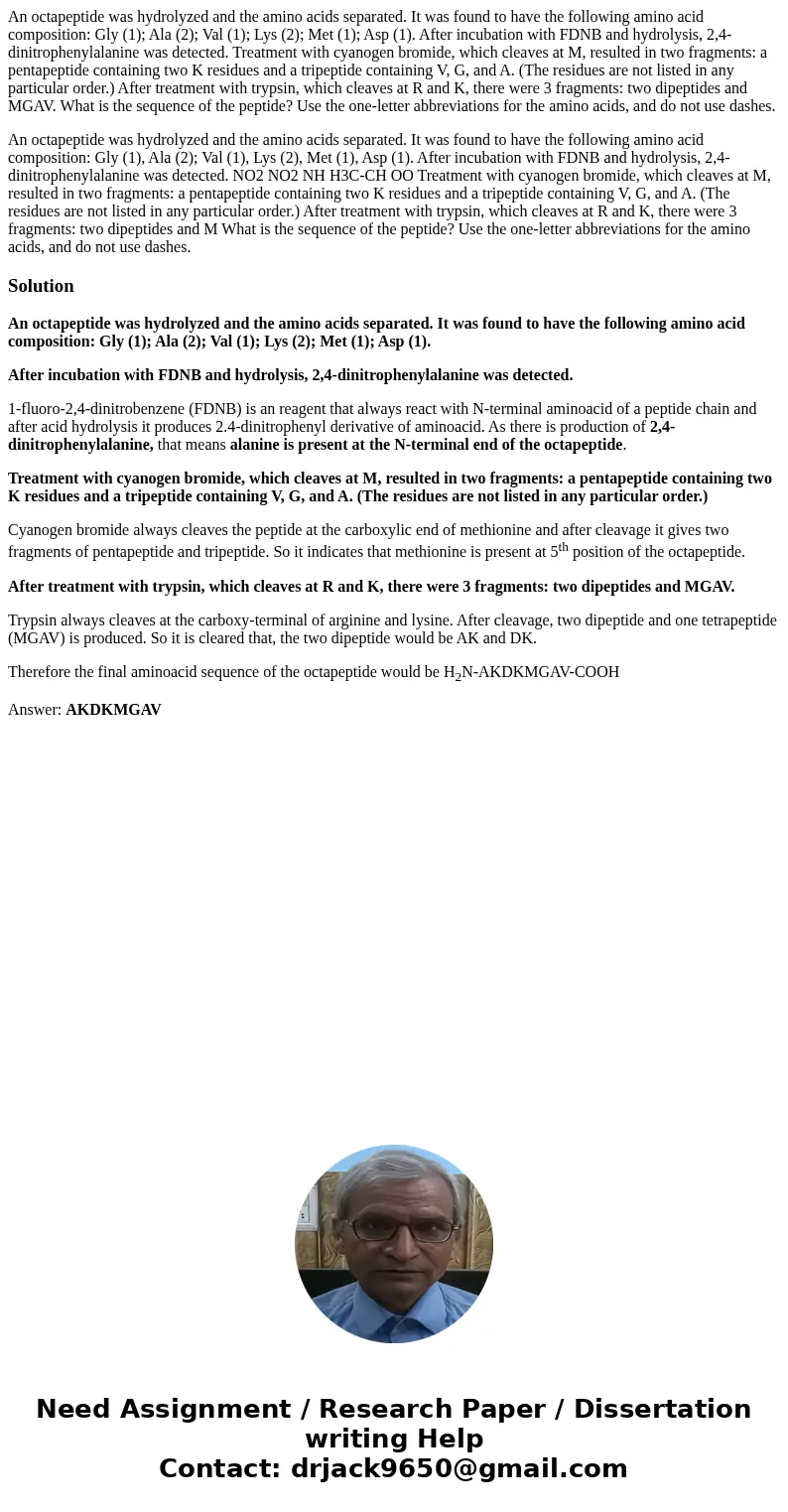An octapeptide was hydrolyzed and the amino acids separated
An octapeptide was hydrolyzed and the amino acids separated. It was found to have the following amino acid composition: Gly (1); Ala (2); Val (1); Lys (2); Met (1); Asp (1). After incubation with FDNB and hydrolysis, 2,4-dinitrophenylalanine was detected. Treatment with cyanogen bromide, which cleaves at M, resulted in two fragments: a pentapeptide containing two K residues and a tripeptide containing V, G, and A. (The residues are not listed in any particular order.) After treatment with trypsin, which cleaves at R and K, there were 3 fragments: two dipeptides and MGAV. What is the sequence of the peptide? Use the one-letter abbreviations for the amino acids, and do not use dashes.
An octapeptide was hydrolyzed and the amino acids separated. It was found to have the following amino acid composition: Gly (1), Ala (2); Val (1), Lys (2), Met (1), Asp (1). After incubation with FDNB and hydrolysis, 2,4-dinitrophenylalanine was detected. NO2 NO2 NH H3C-CH OO Treatment with cyanogen bromide, which cleaves at M, resulted in two fragments: a pentapeptide containing two K residues and a tripeptide containing V, G, and A. (The residues are not listed in any particular order.) After treatment with trypsin, which cleaves at R and K, there were 3 fragments: two dipeptides and M What is the sequence of the peptide? Use the one-letter abbreviations for the amino acids, and do not use dashes.Solution
An octapeptide was hydrolyzed and the amino acids separated. It was found to have the following amino acid composition: Gly (1); Ala (2); Val (1); Lys (2); Met (1); Asp (1).
After incubation with FDNB and hydrolysis, 2,4-dinitrophenylalanine was detected.
1-fluoro-2,4-dinitrobenzene (FDNB) is an reagent that always react with N-terminal aminoacid of a peptide chain and after acid hydrolysis it produces 2.4-dinitrophenyl derivative of aminoacid. As there is production of 2,4-dinitrophenylalanine, that means alanine is present at the N-terminal end of the octapeptide.
Treatment with cyanogen bromide, which cleaves at M, resulted in two fragments: a pentapeptide containing two K residues and a tripeptide containing V, G, and A. (The residues are not listed in any particular order.)
Cyanogen bromide always cleaves the peptide at the carboxylic end of methionine and after cleavage it gives two fragments of pentapeptide and tripeptide. So it indicates that methionine is present at 5th position of the octapeptide.
After treatment with trypsin, which cleaves at R and K, there were 3 fragments: two dipeptides and MGAV.
Trypsin always cleaves at the carboxy-terminal of arginine and lysine. After cleavage, two dipeptide and one tetrapeptide (MGAV) is produced. So it is cleared that, the two dipeptide would be AK and DK.
Therefore the final aminoacid sequence of the octapeptide would be H2N-AKDKMGAV-COOH
Answer: AKDKMGAV

 Homework Sourse
Homework Sourse